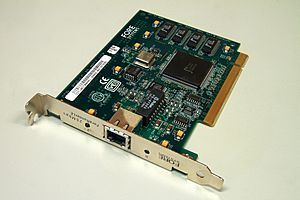Asynchronous Transfer Mode facts for kids
Asynchronous Transfer Mode (ATM) is a special way that computers send information across networks. Think of it like a very organized postal service for digital data. It's mainly used for very large networks, called Wide Area Networks (WANs).
ATM works by breaking down all the information into tiny, fixed-size pieces called "cells" or "packets." Each of these small packets is then sent on its own journey through the network. This method helps make sure data travels smoothly and reliably.
ATM has been very useful in both large WANs and smaller Local Area Networks (LANs). Even today, many ADSL internet connections use ATM technology behind the scenes to send data.
Contents
How ATM Works: Sending Data in Cells
Imagine you want to send a big message. Instead of sending it all at once, ATM cuts it into many small, equal-sized pieces. Each piece is like a tiny envelope.
- Fixed-size packets: Unlike some other network methods, ATM always uses packets of the same small size. This makes it easier to manage the flow of data.
- Virtual paths: Before data is sent, a special "virtual path" is set up across the network. All the packets for that message follow this path.
- Efficient routing: Because the packets are small and follow a set path, ATM can send data very efficiently and quickly.
ATM vs. Ethernet: Predictable Performance
You might have heard of Ethernet, which is a common way to connect computers in a LAN. Ethernet is simpler and works well when there isn't much network traffic.
- Ethernet's challenge: When many people use an Ethernet network at once, it can become unpredictable. It's hard to know exactly when a data packet will arrive. This means Ethernet can't promise a specific delivery time.
- ATM's advantage: ATM is more complex, but this complexity allows it to make promises about how data will travel. It can guarantee things like:
* Data rate: How fast the information will be sent. * Maximum delay: The longest time a packet will take to arrive. * Jitter: How steady the flow of data will be (avoiding choppy connections).
These guarantees are known as Quality of Service (QoS). They are very important for things like video calls or online gaming, where a smooth and timely connection is key.
Images for kids
-
IBM Turboways ATM 155 PCI network interface card
See also
 In Spanish: Modo de transferencia asíncrona para niños
In Spanish: Modo de transferencia asíncrona para niños




